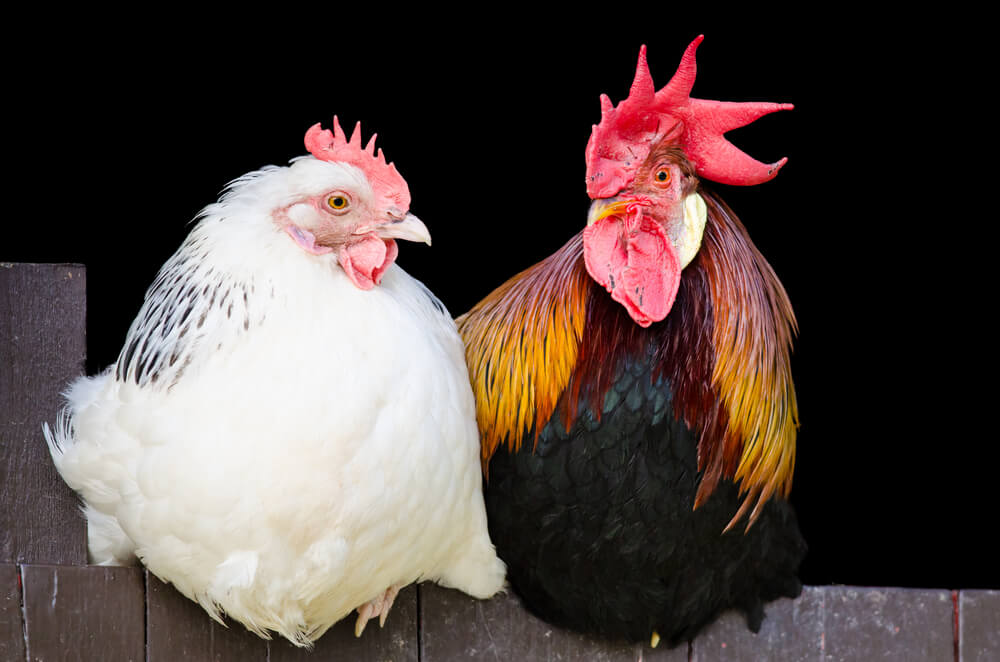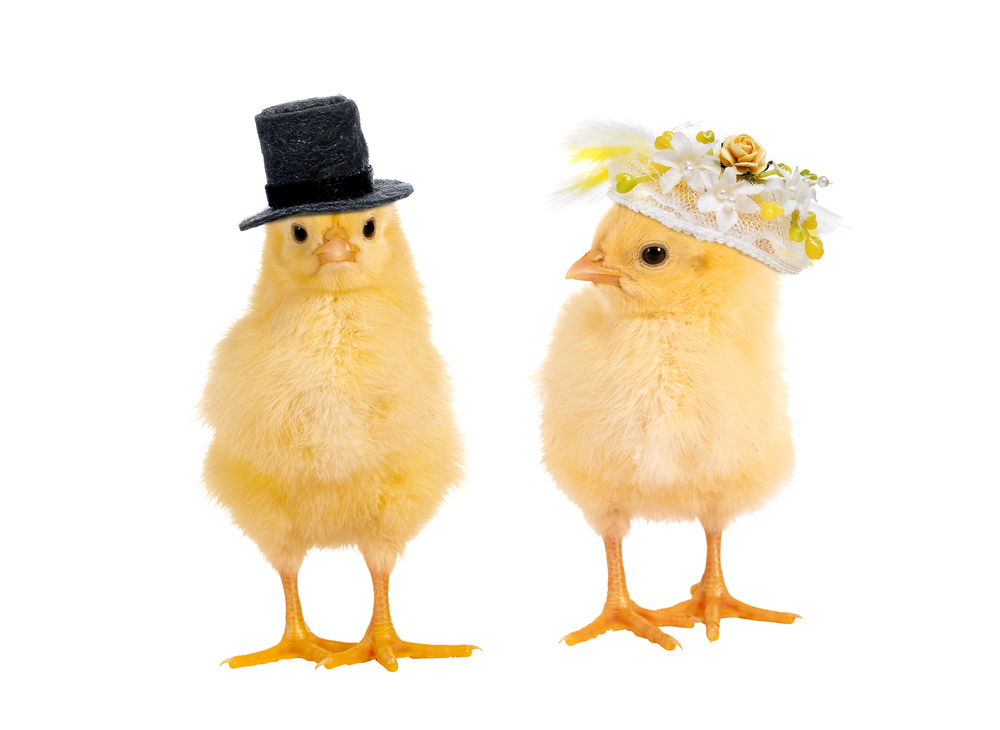5 Differences Between Hens and Roosters
A guide for the new chicken parents among us.
5 Differences Between Hens and Roosters
A guide for the new chicken parents among us.

Know your hens from your roosters.by Roblan/ Shutterstock
So you have a batch of newly-hatched chicks, but don’t know whether they’ll become hens or roosters. While it’s easy to tell the difference between the two when mature chickens strut across your yard, it’s nearly impossible to identify the gender—otherwise known as sexing—of a young chick. You won’t be able to determine with certainty whether they are cockerels (male chickens under one year old) or pullets (female chickens under one year old) until they’re at least 16 weeks old. Here’s what to look for as your chicks mature.
Egg Laying
Of course, whether or not a chicken lays eggs is the obvious way to tell whether you have a hen or rooster. But a hen doesn’t start laying eggs until it’s around six months old, so you’ll have to look at other physical traits to identify the chicken before then.
Combs and Wattles
The comb is the fleshy red crest on top of a chicken’s head. Both sexes have them, but as cockerels mature, they will have larger, brighter and more pronounced combs than the pullets. Roosters will also have larger wattles. This is the elongated fleshy skin that hangs under the beak and helps chickens stay cool during warmer weather.

Feathers
There are various feathers on a chicken that can help you determine whether you have a hen or a rooster. Neck feathers, called hackle feathers, are rounder and shorter on a hen. On a rooster, they are longer and pointier. Different breeds have varying tail feathers, but roosters will always have pointier, longer and showier tail feathers, sometimes with several different colors. Roosters have long saddle feathers, which grow on their back down toward their tail. By the time the bird is about three months old, cockerels will have long and pointed saddle feathers. The pullets, meanwhile, will have rounded ones.
Behavior
Roosters have more stamina and strength than female chickens. Hens tend to be more timid, while roosters are always more assertive. Roosters tend to be bossy, even when they’re young. As they get older, you’ll notice that roosters begin to challenge each other, raising their hackle feathers. Plus, they crow the morning cock-a-doodle-do!
Leg Size
The last characteristic to help you identify the difference between hens and roosters is their leg size. Male chickens will have thicker legs than the females. In some breeds, roosters develop pointed, sharp spurs on their legs just above their toes. At six months old, a rooster’s spurs will be less than a third of an inch long. As they age, spurs can grow to reach more than an inch in length. Roosters use spurs to defend themselves. This can be dangerous, particularly if it’s an aggressive rooster. Luckily, there are safe ways to remove them.
Follow us
This work is licensed under a Creative Commons Attribution-NoDerivatives 4.0 International License.
Want to republish a Modern Farmer story?
We are happy for Modern Farmer stories to be shared, and encourage you to republish our articles for your audience. When doing so, we ask that you follow these guidelines:
Please credit us and our writers
For the author byline, please use “Author Name, Modern Farmer.” At the top of our stories, if on the web, please include this text and link: “This story was originally published by Modern Farmer.”
Please make sure to include a link back to either our home page or the article URL.
At the bottom of the story, please include the following text:
“Modern Farmer is a nonprofit initiative dedicated to raising awareness and catalyzing action at the intersection of food, agriculture, and society. Read more at <link>Modern Farmer</link>.”
Use our widget
We’d like to be able to track our stories, so we ask that if you republish our content, you do so using our widget (located on the left hand side of the article). The HTML code has a built-in tracker that tells us the data and domain where the story was published, as well as view counts.
Check the image requirements
It’s your responsibility to confirm you're licensed to republish images in our articles. Some images, such as those from commercial providers, don't allow their images to be republished without permission or payment. Copyright terms are generally listed in the image caption and attribution. You are welcome to omit our images or substitute with your own. Charts and interactive graphics follow the same rules.
Don’t change too much. Or, ask us first.
Articles must be republished in their entirety. It’s okay to change references to time (“today” to “yesterday”) or location (“Iowa City, IA” to “here”). But please keep everything else the same.
If you feel strongly that a more material edit needs to be made, get in touch with us at [email protected]. We’re happy to discuss it with the original author, but we must have prior approval for changes before publication.
Special cases
Extracts. You may run the first few lines or paragraphs of the article and then say: “Read the full article at Modern Farmer” with a link back to the original article.
Quotes. You may quote authors provided you include a link back to the article URL.
Translations. These require writer approval. To inquire about translation of a Modern Farmer article, contact us at [email protected]
Signed consent / copyright release forms. These are not required, provided you are following these guidelines.
Print. Articles can be republished in print under these same rules, with the exception that you do not need to include the links.
Tag us
When sharing the story on social media, please tag us using the following: - Twitter (@ModFarm) - Facebook (@ModernFarmerMedia) - Instagram (@modfarm)
Use our content respectfully
Modern Farmer is a nonprofit and as such we share our content for free and in good faith in order to reach new audiences. Respectfully,
No selling ads against our stories. It’s okay to put our stories on pages with ads.
Don’t republish our material wholesale, or automatically; you need to select stories to be republished individually.
You have no rights to sell, license, syndicate, or otherwise represent yourself as the authorized owner of our material to any third parties. This means that you cannot actively publish or submit our work for syndication to third party platforms or apps like Apple News or Google News. We understand that publishers cannot fully control when certain third parties automatically summarize or crawl content from publishers’ own sites.
Keep in touch
We want to hear from you if you love Modern Farmer content, have a collaboration idea, or anything else to share. As a nonprofit outlet, we work in service of our community and are always open to comments, feedback, and ideas. Contact us at [email protected].by Shelby Vittek, Modern Farmer
May 30, 2021
Modern Farmer Weekly
Solutions Hub
Innovations, ideas and inspiration. Actionable solutions for a resilient food system.
ExploreExplore other topics
Share With Us
We want to hear from Modern Farmer readers who have thoughtful commentary, actionable solutions, or helpful ideas to share.
SubmitNecessary cookies are absolutely essential for the website to function properly. This category only includes cookies that ensures basic functionalities and security features of the website. These cookies do not store any personal information.
Any cookies that may not be particularly necessary for the website to function and are used specifically to collect user personal data via analytics, ads, other embedded contents are termed as non-necessary cookies.
Hi its easy just look at the attached image
Roosters….”Plus, they crow the morning” so does our 1 remaining hen!
Also, the rooster that matures first will assert dominance and the remaining cockerels will try to escape the coop/enclosure.
I have several of those. Very docile birds. They panic easily though and will have you startled a-lot, thinking they are being ambushed by a freggin’ bobcat. They come highly recommended for first time chicken owners as they just don’t like to fight. One hilarious thing about my oldest one is my only male guinea is in love with her and follows her everywhere! It’s great! LoL
Yes
I am Gilbert Roel, professor of biology. I saw a taxidermy representation of an adult rooster that had a 12 inch reptilian tail.
i like frankcolin and han